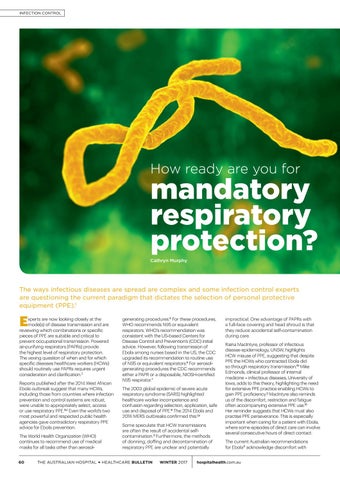INFECTION CONTROL
How ready are you for
mandatory respiratory protection? Cathryn Murphy
The ways infectious diseases are spread are complex and some infection control experts are questioning the current paradigm that dictates the selection of personal protective equipment (PPE).1
E
xperts are now looking closely at the mode(s) of disease transmission and are reviewing which combinations or specific pieces of PPE are suitable and critical to prevent occupational transmission. Powered air-purifying respirators (PAPRs) provide the highest level of respiratory protection. The vexing question of when and for which specific diseases healthcare workers (HCWs) should routinely use PAPRs requires urgent consideration and clarification.2 Reports published after the 2014 West African Ebola outbreak suggest that many HCWs, including those from countries where infection prevention and control systems are robust, were unable to appropriately select, access or use respiratory PPE.3,4 Even the world’s two most powerful and respected public health agencies gave contradictory respiratory PPE advice for Ebola prevention. The World Health Organization (WHO) continues to recommend use of medical masks for all tasks other than aerosol60
generating procedures.5 For these procedures, WHO recommends N95 or equivalent respirators. WHO’s recommendation was consistent with the US-based Centers for Disease Control and Prevention’s (CDC) initial advice. However, following transmission of Ebola among nurses based in the US, the CDC upgraded its recommendation to routine use of N95 or equivalent respirators.6 For aerosolgenerating procedures the CDC recommends either a PAPR or a disposable, NIOSH-certified N95 respirator.7 The 2003 global epidemic of severe acute respiratory syndrome (SARS) highlighted healthcare worker incompetence and confusion regarding selection, application, safe use and disposal of PPE.8 The 2014 Ebola and 2016 MERS outbreaks confirmed this.1,9 Some speculate that HCW transmissions are often the result of accidental selfcontamination.3 Furthermore, the methods of donning, doffing and decontamination of respiratory PPE are unclear and potentially
THE AUSTRALIAN HOSPITAL + HEALTHCARE BULLETIN
WINTER 2017
impractical. One advantage of PAPRs with a full-face covering and head shroud is that they reduce accidental self-contamination during care. Raina MacIntyre, professor of infectious disease epidemiology, UNSW, highlights HCW misuse of PPE, suggesting that despite PPE the HCWs who contracted Ebola did so through respiratory transmission.10 Mike Edmonds, clinical professor of internal medicine – infectious diseases, University of Iowa, adds to this theory, highlighting the need for extensive PPE practice enabling HCWs to gain PPE proficiency.3 MacIntyre also reminds us of the discomfort, restriction and fatigue often accompanying extensive PPE use.10 Her reminder suggests that HCWs must also practise PPE perseverance. This is especially important when caring for a patient with Ebola, where some episodes of direct care can involve several consecutive hours of direct contact. The current Australian recommendations for Ebola11 acknowledge discomfort with
hospitalhealth.com.au
